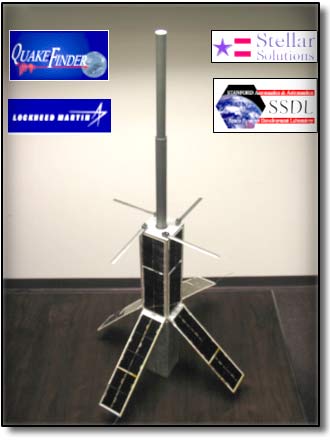About QuakeSat

QuakeSat was a small satellite, 4″x4″x12″, launched on June 30, 2003, to provide a “proof-of-concept” for collecting ULF earthquake precursor signals from space. The design was based on the CubeSat concept where each CubeSat is 4″x4″x4″. QuakeSat was in fact a triple CubeSat to provide a large enough size to include a one-foot long magnetometer that extends on a telescoping boom.
The mission goal of QuakeSat was to determine if there were any ultra low frequency (ULF) magnetic signals, associated with large earthquakes, that could be detected using a satellite-based induction magnetometer flying in low earth orbit (LEO).
The satellite was a collaboration between the Space Systems Development Laboratory at Stanford University, under the direction of Professor Robert Twiggs, and QuakeFinder, R&D division of Stellar Solutions in Palo Alto, CA.
The students in this class were from Lockheed Martin, in Sunnyvale, CA. and together with the staff of QuakeFinder, they designed and prototyped the satellite subsystems. Construction took about 18 mos., and launch was arranged through University of Toronto, and executed under a contract with Eurokot in Russia.
For more information on QuakeSat:
- View our Technical Papers: Papers by Quakefinder & Papers by Others
- Download the, “QuakeSat Lessons Learned” PDF Document
- Download the, “A CubeSat Derived Design…”
- View the Stanford/QuakeSat Webpage
At this time, there are no plans to build a QuakeSat-II, partially due to funding limitations, and partly due to the observation that the ULF signals appear to be short-lived pulsations (1-10 sec in duration) that exist for approximately 5-10% of a 24 hr day. A low earth satellite only has visibility over a specific earthquake area for approximately 2-15 minutes per day (less than 1 % of the day), so it is statistically difficult to be at the right place when these pulsations occur.
